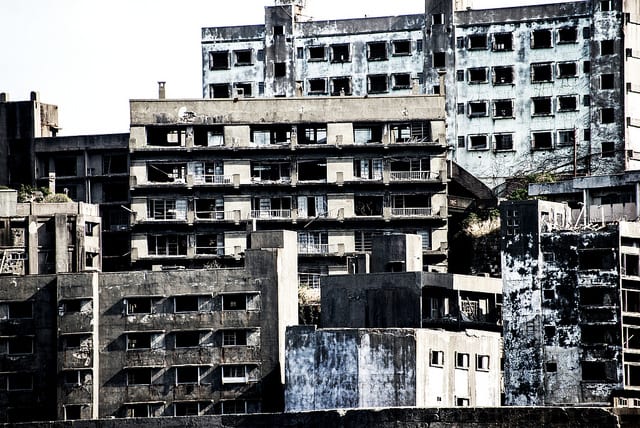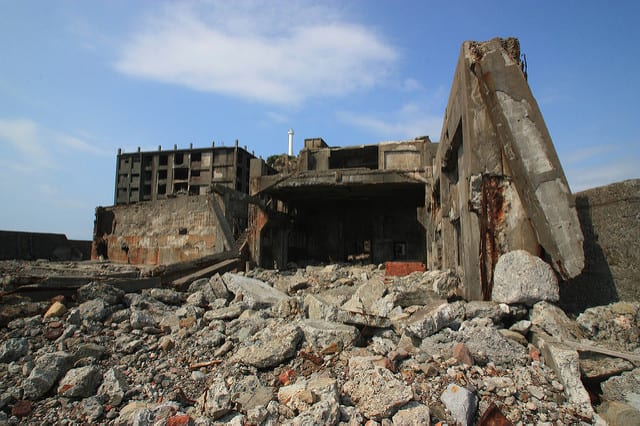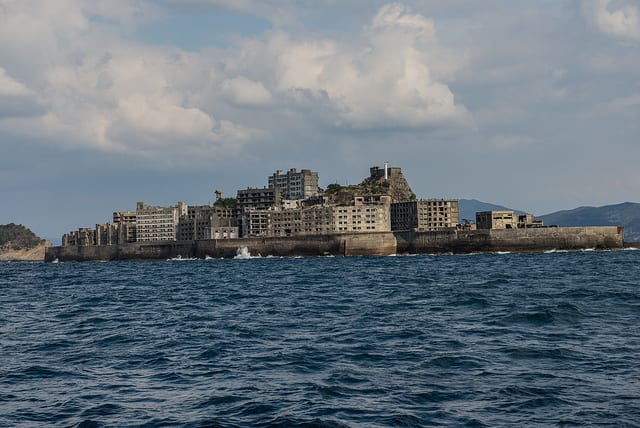Nine miles south of the port city of Nagasaki is a decaying reminder of Japan’s dark past.
Hashima Island lies among 500-plus desolate islands in the Nagasaki Prefecture, yet its crumbling industrial landscape sets it apart from the rest of the region. Commonly referred to as Gunkanjima or “Battleship Island,” it resembles an approaching warship with its concrete sea walls and towering grey buildings.

Photo Credit: Flickr, ajari
Japan discovered coal deposits beneath the island in 1887; manufacturing company Mitsubishi bought the island three years later, erecting towering concrete apartments in 1916 to house miners and their families. Soon, Hashima was a fully functioning, 16-acre city complete with living quarters, schools, marketplaces, sports facilities, a theater, and a hospital.
In the 1930s and through World War II, Japan’s industrial ambitions and wartime efforts negatively impacted life on Hashima. Korean civilians and Chinese prisoners of war were forced into servitude, laboring for hours in the coal mines below. Surviving workers tell chilling tales of cramped quarters, starvation, backbreaking work, and work-related deaths.

Photo Credit: Flickr, Kenta Mabuchi
Gradually, life on Hashima improved. Fresh water was pumped in from underground pipes beginning in 1957 and small gardens took root on the rooftops above. By 1959, with 5,259 residents squeezed onto the island’s slim 16 acres, it represented one of the most densely populated place in the world.
Such golden years were short-lived. As coal levels dropped and petroleum became a more valuable energy source, Hashima’s industrial might dwindled. In 1974, Mitsubishi was forced to shut down the mines beneath the island. It wasn’t long before families simply left their homes, sailing back to shore in search of new work, often leaving their belongings behind.

Photo Credit: Flickr, Kenta Mabuchi
With its residents gone, Hashima fell into abandonment, decaying off the coast of Japan for decades.
The island was finally reopened in 2009; it became a UNESCO World Heritage Site earlier this year. Intrepid explorers can now take a 50-minute boat ride to visit Hashima—though the rough conditions of the East China Sea often make the journey last much longer.
What remains is an eerie ghost town, with crumbling facades ravaged by more than 30 years of harsh sea weather. Living quarters are still intact, with furniture and table settings collecting dust — a shadow of what life was like in the middle of the ocean some thirty years ago. A shrine where locals worshipped still stands, as do foreboding entrances to mine shafts. Because of risk from falling debris and unstable structures, the viewing areas remain limited.

Photo Credit: Flickr, ajari
As you wander the deserted streets of Hashima Island, you undoubtedly feel like the last living soul in a long-lost world.
This story was first published on The Lineup
Read more below:
9 American Horror Story Characters Based on Real-Life Killers
8 Real-Life Cabin in the Woods Murders That Will Make You Lock Your Doors






